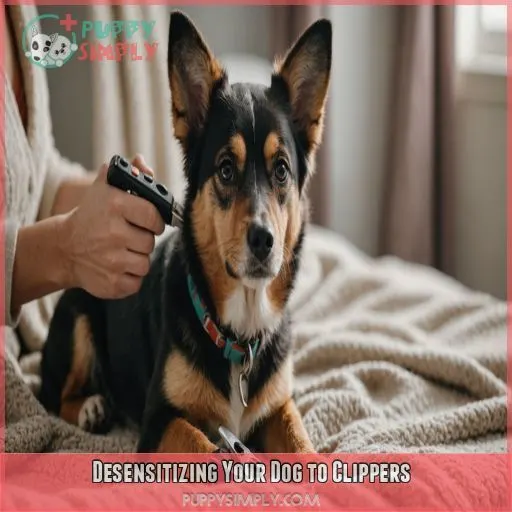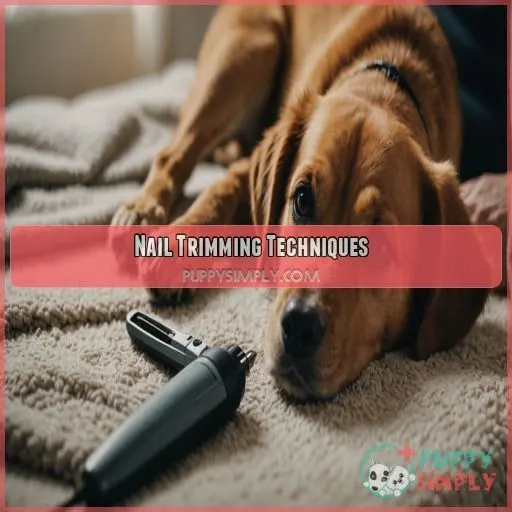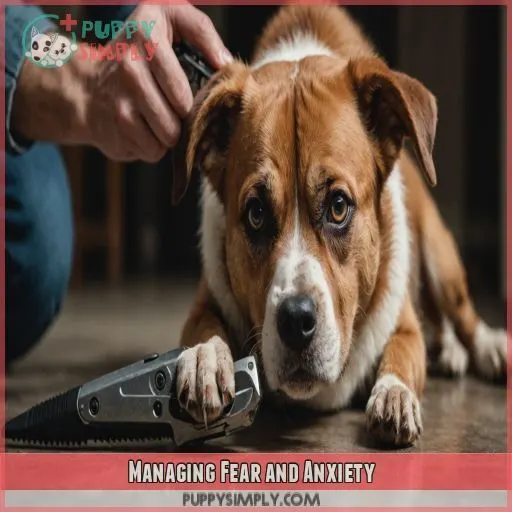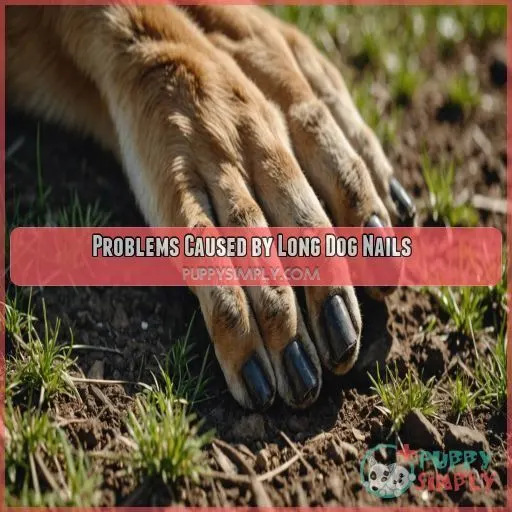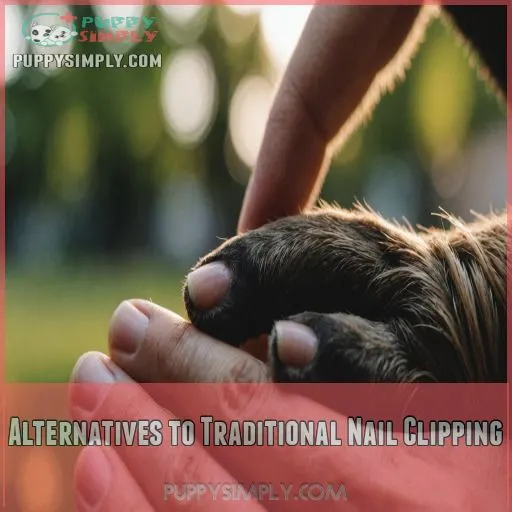This site is supported by our readers. We may earn a commission, at no cost to you, if you purchase through links.
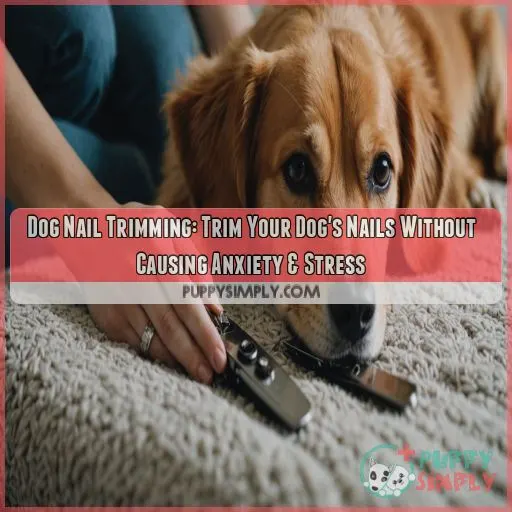
Don’t worry, with a gentle approach, you can make nail trimming a breeze for both of you.
Start by getting your dog accustomed to the clippers, rewarding calmness with treats and praise.
Gradually introduce the sound and sensation of the clippers, and before you know it, nail trimming will become a bonding experience.
By desensitizing your dog to clippers and using positive reinforcement, you can trim your dog’s nails without causing anxiety, making the experience enjoyable for both of you.
Want to learn the secrets to a stress-free nail trimming session?
Table Of Contents
- Key Takeaways
- Why Dogs Fear Nail Trimming
- Desensitizing Your Dog to Clippers
- Nail Trimming Techniques
- Managing Fear and Anxiety
- Problems Caused by Long Dog Nails
- Alternatives to Traditional Nail Clipping
- Building Trust and Making Nail Trimming a Bonding Experience
- Frequently Asked Questions (FAQs)
- How to cut your dog’s nails without them freaking out?
- How can I cut my dog’s nails if he won’t let me?
- What can I give my dog to calm him down for nail trimming?
- What is the alternative to nail clipping dogs?
- How often should I trim my dogs nails?
- What is the best time of day to trim nails?
- Can I trim my dogs nails after exercise or play?
- How do I choose the right nail clippers for my dog?
- What should I do if my dogs nail starts bleeding?
- Conclusion
Key Takeaways
- You can make nail trimming a breeze for both you and your furry friend by getting your dog accustomed to the clippers, rewarding calmness with treats and praise, and gradually introducing the sound and sensation of the clippers.
- Desensitization is key: use positive reinforcement to help your dog associate nail trimming with good things, and handle their paws regularly to make it a gentle, enjoyable experience.
- Long dog nails can lead to a host of problems that affect your dog’s comfort, health, and even your furniture, so it’s crucial to trim those nails regularly; consider using a Dremel or other alternatives to traditional nail clipping.
- By approaching nail trimming with patience, consistency, and positive reinforcement, you can turn a potentially anxiety-inducing task into a rewarding experience for both you and your furry friend, and strengthen your bond in the process.
Why Dogs Fear Nail Trimming
You’re not alone if your dog turns into a quivering mess at the mere sight of nail clippers.
Many dogs develop a strong fear of nail trimming due to past negative experiences, sensitivity, or anxiety.
Past Negative Experiences
If your dog has had a painful or traumatic nail trimming experience in the past, it’s no wonder they’re fearful of the process. Those negative memories can create lasting anxiety. But with patience and the right approach, you can help your pup overcome their clipper phobia and make nail trims a breeze.
Sensitivity and Anxiety
Your furry friend might be super sensitive, making nail trimming a tough task. Some dogs are naturally more anxious, and the sensation of nail trimming can be overwhelming. To ease their anxiety, try positive reinforcement techniques, like treats and praise, to create a calming atmosphere. This will help your dog associate nail trimming with good vibes, not stress.
Sound of Clippers
The sound of clippers can be downright terrifying for some dogs. If your furry friend is clipper-noise sensitive, don’t worry, you’re not alone. Here are three ways to put yourself in your dog’s paws:
- Imagine being in a quiet room when suddenly a lawnmower starts outside.
- Picture nails on a chalkboard – that’s what clipper noise can be like for dogs.
- Think of a fire alarm blaring in your ear – not pleasant, right?
Pressure on Paws
The pressure on paws – another culprit behind your dog’s nail-trimming anxiety. You see, some dogs are super sensitive about their paws, and the pressure of the clippers can be uncomfortable or even painful. You should think about your dog’s paw anatomy and pain tolerance when trimming their nails. A gentle clipper technique can make all the difference.
Sight of Sharp Tools
The sight of sharp tools – it’s enough to make anyone nervous, let alone your furry friend! Dogs may associate nail clippers with pain or discomfort, leading to anxiety. Here are 4 ways to help your dog feel more at ease:
- Gradual exposure: Let your dog see the clippers at a distance, then gradually bring them closer.
- Positive association: Reward your dog with treats and praise when they remain calm near the clippers.
- Safety tips: Choose a quiet, distraction-free area for nail trimming, and consider a second person to assist.
- Desensitization: Touch your dog’s paws with the clippers while giving treats, helping them become comfortable with the sensation.
Dewclaw Removal
If your dog has undergone dewclaw removal, this might be the culprit behind their nail trimming anxiety. The surgery can be painful, and post-surgery care may have involved nail handling, creating a negative association. Be gentle and patient, as your dog may need extra reassurance during nail trimming. Consider alternative methods to help them feel more comfortable.
Inadequate Handling
As a puppy parent, you play a significant role in shaping your dog’s nail trimming experience. Early handling and socialization can make all the difference. Gentle touch and positive reinforcement can help your pup become confident and calm during nail trimming. Start with short sessions and gradually increase touch sensitivity to set your dog up for success.
Lack of Experience
If you’ve recently adopted a rescue dog or are a new owner, your furry friend might be unfamiliar with nail trimming.
This lack of experience can cause anxiety and stress.
Start with small steps, such as gently touching their paws and introducing the clippers.
Make it a positive experience with treats and praise, building trust and confidence for future nail trims.
Physical Sensitivity
Your dog’s physical sensitivity might be the culprit behind their nail trimming anxiety. Some breeds are naturally more touch-sensitive, while others may have individual quirks. To make nail trimming a breeze, try gentle handling and pain management techniques. Be mindful of sensory overload and use dog nail trimming clippers specifically designed for comfort and safety.
Negative Past Experiences
Negative past experiences can be a major contributor to your dog’s nail-trimming anxiety. Maybe you accidentally cut the quick or handled their paws roughly in the past. These experiences can leave a lasting impression, triggering fear and anxiety at the sight of clippers. Don’t worry, it’s not too late to make amends and rewire their brain with positive associations.
Desensitizing Your Dog to Clippers
You’re about to take a huge step in making nail trimming a breeze for both you and your furry friend – getting your dog comfortable with those scary clippers. By following some simple steps, you can desensitize your dog to the sight, sound, and feel of clippers, making nail trimming a stress-free experience for everyone involved.
Getting Your Dog Accustomed to Clippers
Now that we’ve explored why dogs fear nail trimming, it’s time to help your furry friend feel more comfortable around clippers. Start by simply showing them the clippers, then reward them with treats and praise for remaining calm. Repeat this process several times, creating a positive association with the clippers. Gradual exposure is key to successful desensitization.
Training Your Dog to Allow Paw Handling
Now it’s time to get your dog comfortable with paw handling. Start by gently massaging their paws, making it a positive experience with treats and praise. Gradually increase the pressure and focus on individual toes. Be patient and go at your dog’s pace. Building trust and handling sensitivity takes time, but it’s really important for stress-free nail trimming.
Introducing the Sound of Clippers
Now it’s time to introduce the sound of clippers to your dog. Start by simply turning them on and off at a distance, rewarding your dog with treats and praise for remaining calm. Gradually decrease the distance, allowing your dog to associate the sound with positive reinforcement. This step is really important in getting your dog used to the clippers.
Combining Paw Handling With Clippers
Now that your dog is comfortable with the sound of clippers, it’s time to combine paw handling with the clippers. Hold your dog’s paw while the clippers are on, but not touching their nails. Reward them with treats and praise for remaining calm. This step helps your dog associate the clippers with positive reinforcement.
- Imagine your dog’s confidence growing with each passing day
- Envision the relief you’ll feel when nail trimming becomes a breeze
- Picture the special bond you’ll form with your dog through this process
- Think about the treats and praise that will make this journey worthwhile
Touching Clippers to Toes
Now it’s time to touch those clippers to your dog’s toes. Start by gently touching the clippers to their toes while giving treats and praise. This helps your dog associate the clippers with positive experiences.
| Step | Action |
|---|---|
| 1 | Hold your dog’s paw firmly but gently |
| 2 | Touch the clippers to their toes for a second |
| 3 | Reward with treats and praise immediately |
| 4 | Repeat steps 1-3 several times |
| 5 | Gradually increase the touch duration |
Creating a Positive Association
Now that your dog is comfortable with the clippers touching their toes, it’s time to create a positive association. Place the clippers near their favorite treats or toys, so they start to link the two. This simple trick helps your dog view nail trimming as a pleasant experience.
- Use treats to create a positive connection
- Place clippers near favorite toys or chews
- Associate nail trimming with rewards and praise
Nail Trimming Techniques
Now that your dog is comfortable with the clippers, it’s time to start trimming those nails – and with the right techniques, you can make the experience stress-free for both of you. By following a few simple steps, you’ll be able to keep your dog’s nails healthy and tidy, without causing them any anxiety or discomfort.
Trimming the Tip of the Nail
Now that your dog is comfortable with clippers, it’s time to start trimming those nails. Begin by trimming the very tip of the nail, just a tiny snip. Reward your dog with praise and treats after each nail. Remember, it’s all about baby steps. You want to build confidence and trust, not stress them out. Keep it short and sweet!
Avoiding the Quick
Now that you’ve trimmed the tip of the nail, it’s important to avoid the quick, the sensitive part of the nail that contains nerves and blood vessels. Cutting the quick can be painful for your dog and cause bleeding. To avoid this:
- Familiarize yourself with the quick’s location, which varies by dog breed and nail shape.
- Trim a little at a time, taking breaks to inspect the nail.
- Use a styptic powder or a pet nail clotting gel to stop any bleeding.
- Consider investing in dog nail trimming insurance to cover any accidents.
Rewarding Your Dog
After avoiding the quick, it’s time to reward your dog for staying calm. Positive reinforcement is key! Use treats, praise, and affection to show your dog that nail trimming isn’t so bad.
| Reward Type | Description |
|---|---|
| Treats | Yummy snacks to associate with nail trimming |
| Praise | Verbal encouragement to boost confidence |
| Toy Rewards | Favorite toys to make the experience fun |
| Affection | Physical touch to show love and appreciation |
Dividing the Trimming Process
To make nail trimming a breeze, divide the process into smaller, manageable chunks. Trim one or two nails at a time, taking breaks in between to give your dog a chance to relax. This approach helps prevent overwhelming your furry friend and allows you to gauge their comfort level, adjusting your trimming schedule accordingly.
Sharpening Clipper Blades
Don’t underestimate the importance of sharp clippers! Dull blades can cause more harm than good. Here are four things to keep in mind:
- Choose the right blade type: Select a blade suitable for your dog’s nail type.
- Sharpen frequently: Sharpen clippers every 3-5 uses to maintain effectiveness.
- Prioritize safety: Wear gloves and use a sharpening stone or tool.
- Consider DIY or professional tools: Invest in a sharpening kit or take your clippers to a pro.
Trimming a Small Portion at a Time
When trimming your dog’s nails, try the "small steps" approach. Trim just a tiny portion of one nail at a time, rewarding your dog with praise and treats for each tiny success. This gradual approach helps build trust and confidence. By focusing on small wins, you’ll make nail trimming a positive experience for both you and your furry friend.
Managing Fear and Anxiety
As you work on trimming your dog’s nails, it’s important to notice and deal with any fear or anxiety they might be feeling. By recognizing the signs of distress and taking a gentle, patient approach, you can help your furry friend feel more at ease and make nail trimming a less stressful task for both of you.
Consulting a Veterinarian
When nail trimming anxiety strikes, don’t hesitate to consult a veterinarian for expert guidance. They’ll help you:
- Identify underlying causes of anxiety
- Develop a customized trimming plan
- Choose vet-approved clippers for a painless experience
- Determine the ideal nail trimming frequency for your furry friend
Your vet is there to support you and your pup.
Medication for Anxiety
If your vet recommends anxiety meds, follow their guidance on dosage and potential side effects. You may also explore natural remedies, like pheromone diffusers or calming treats, to help your dog relax during nail trimming. Remember, medication should be a last resort, and always consult with your vet before giving your dog any new substances.
Avoiding Scolding or Punishment
Here’s the thing: scolding or punishing your dog for being anxious or resistant to nail trimming is a huge no-no. It’ll only create more stress and make the experience even more traumatic. Instead, focus on positive reinforcement and building trust. Be patient and gentle, and remember, it’s okay to take things slow. Your dog will thank you.
Focusing on Desensitization
Trying to handle your dog’s nail-trimming anxiety? Focusing on desensitization is key. Use positive reinforcement to help your dog associate nail trimming with good things. Gradually expose them to the clippers, rewarding calmness along the way. Handle their paws regularly, making it a gentle, enjoyable experience. By building trust, you’ll make nail trimming a breeze for both of you.
Creating a Relaxed Environment
To create a relaxed environment for nail trimming, set the mood with calming music and soft lighting. Choose a quiet, safe space where your dog feels comfortable and secure. Use positive reinforcement and gentle handling to reassure them that everything will be okay. Your goal is to make nail trimming a stress-free experience.
- Imagine your dog’s happy face when they realize nail trimming isn’t so bad after all
- Envision the sense of accomplishment you’ll feel when you successfully trim their nails without causing anxiety
- Picture the special bond you’ll form with your dog as you work together to overcome their fears
- See yourself as a confident, patient, and compassionate dog parent who can handle anything that comes your way
Taking Breaks
When your dog shows signs of stress, it’s time to take a break. Pay attention to their signals – yawning, licking, or avoiding eye contact. Take breaks every 5-10 minutes to let them relax. Use calming techniques like treats, massages, or soothing music. Reward their calm behavior with positive reinforcement, and consider alternative methods if needed.
Seeking Help From a Dog Training Service
If your dog’s nail-trimming anxiety is overwhelming, consider seeking help from a professional dog training service. A certified trainer can help you develop a customized plan to gradually build your dog’s confidence. Research local services, compare costs, and ask about their training methods to find the best fit for you and your furry friend.
Problems Caused by Long Dog Nails
As you work to overcome your dog’s nail trimming anxiety, it’s important to remember why regular trims are so important.
Long nails can lead to a host of problems that affect your dog’s comfort, health, and even your furniture.
Joint and Posture Problems
When your dog’s nails get too long, it can affect their gait, leading to joint pain and posture issues. Imagine walking in shoes that are too big – it’s uncomfortable and awkward! Long nails can cause your dog’s paws to splay or twist, leading to leg deformities and even arthritis.
- Altered dog gait due to long nails
- Strain on joints, particularly in older dogs
- Potential for long-term damage, such as leg deformities
Injuries and Infections
In addition to joint and posture problems, long dog nails can also lead to injuries and infections. When nails split or break, they can be painful and expose the sensitive quick to bacteria. To prevent this, keep an eye out for signs of nail problems and trim your dog’s nails regularly.
| Nail Injuries | Infection Prevention | Paw Care Tips |
|---|---|---|
| Split or broken nails | Keep the nail area clean | Trim nails carefully |
| Quick cutting | Apply antibiotic ointment | Avoid cutting too short |
| Nail overgrowth | Monitor for signs of infection | Use a nail file or grinder |
Paw Deformities
Neglecting nail trimming can lead to paw deformities. As a responsible dog owner, it’s really important to take preventative measures. Here are 4 alarming consequences of paw deformities:
- Arthritis: Misaligned joints cause chronic pain.
- Mobility issues: Deformed paws make walking difficult.
- Infection risk: Ingrown nails or cracks invite bacteria.
- Permanent damage: Irreversible deformities can occur.
Trim those nails to keep your furry friend’s paws healthy!
Difficulty Walking
Is your dog limping or struggling to walk? Long nails might be the culprit! Overgrown nails can alter your dog’s gait, causing joint issues and paw pain. An uneven stride can lead to discomfort and even injuries. Keep your furry friend walking tall by trimming those nails regularly. Your dog will thank you for the relief!
Damage to Furniture
You know the struggle – long dog nails can wreak havoc on your furniture. Consider using dog nail guards or scratch deterrents to protect your belongings. You can also opt for pet-friendly furniture or DIY solutions like nail caps or scratch pads. Protecting your furniture from those pesky nails is a sanity-saver and budget-friendly too!
Alternatives to Traditional Nail Clipping
If traditional nail clipping has become a source of stress for both you and your dog, it’s time to explore alternative options that can make nail trimming a breeze. From using a Dremel to other innovative methods, you’ll discover that there are plenty of ways to keep your dog’s nails in tip-top shape without causing anxiety.
Using a Dremel
Now that we’ve covered the problems caused by long dog nails, let’s explore an alternative to traditional nail clipping: using a Dremel. This method can be a game-changer for anxious dogs. Here are three things to keep in mind:
- Start with low-speed settings to get your dog accustomed to the sound.
- Use a steady, gentle touch to avoid accidents.
- Practice Dremel safety by keeping loose clothing tied back.
Benefits of a Dremel
You’ve decided to give a Dremel a try.
Now, let’s talk about the benefits!
Compared to clippers, a Dremel offers a quieter trimming experience, which means less stress for your furry friend.
It’s also faster and produces smoother nails.
With a Dremel, you can say goodbye to those pesky nail splits and hello to a more enjoyable nail-trimming experience for both you and your dog.
Other Alternatives to Nail Clipping
You’ve got alternatives to traditional nail clipping! Consider nail grinders or dog nail files for a smoother, less intimidating experience. Natural nail wear can also be encouraged through regular exercise on rough surfaces. If you’re not comfortable with DIY solutions, consult professional groomers for guidance. They’ll help you find the best approach for your furry friend’s nail care.
Building Trust and Making Nail Trimming a Bonding Experience
As you work on making nail trimming a stress-free experience for your dog, remember that it’s also an opportunity to strengthen your bond and build trust. By approaching nail trimming with patience, consistency, and positive reinforcement, you can turn a potentially anxiety-inducing task into a rewarding experience for both you and your furry friend.
Approaching Nail Trimming as a Bonding Experience
Now that you’ve explored alternatives to traditional nail clipping, it’s time to shift your mindset: nail trimming can be a bonding experience! By using positive reinforcement, treats, and praise, you can make this often-dreaded task a gentle, loving interaction. With patience and consistency, your furry friend will learn to trust you, and nail trimming will become a breeze.
Building Trust With Your Dog
As you approach nail trimming as a bonding experience, focus on building trust with your dog. Use positive reinforcement, like treats and praise, to create a consistent routine. Pay attention to your dog’s body language, and adjust your approach accordingly. Gentle handling and a calming environment will help your dog feel more at ease, making nail trimming a breeze.
Making Nail Trimming a Positive Experience
You’re doing great! Now, let’s make nail trimming a positive experience for your furry friend. Reward them with treats and praise after each trim. Use positive reinforcement techniques, like gentle handling and soothing words, to calm their nerves. With patience and consistency, your pup will learn to associate nail trimming with good vibes, not anxiety.
Frequently Asked Questions (FAQs)
How to cut your dog’s nails without them freaking out?
Want to trim your dog’s nails without the freakout? Start by getting them used to the clippers, then gradually introduce paw handling and the sound of clipping. Reward calm behavior and take breaks if needed – patience is key!
How can I cut my dog’s nails if he won’t let me?
Don’t worry, I’ve got you covered! To cut your dog’s nails when they won’t let you, start by desensitizing them to the clippers and gradually build trust through positive reinforcement, patience, and consistent practice (Source).
What can I give my dog to calm him down for nail trimming?
To calm your dog for nail trimming, consider treats, toys, or a relaxing massage. For severe anxiety, consult a veterinarian about calming aids like pheromone diffusers, calming collars, or medication to help make the experience less stressful.
What is the alternative to nail clipping dogs?
Did you know 75% of dogs show signs of anxiety during nail clipping? Instead, try nail grinding or Dremeling, a painless and stress-free alternative that smooths the edges, making it a great option for anxious pups.
How often should I trim my dogs nails?
You should trim your dog’s nails every 4-6 weeks, but this can vary depending on their lifestyle, breed, and individual growth rate. Keep an eye on those nails and trim them when you notice they need it!
What is the best time of day to trim nails?
Imagine a peaceful morning, your furry friend by your side. Trim their nails when they’re most relaxed, like after a gentle walk or playtime. Avoid trimming after exercise or meals to minimize stress and discomfort.
Can I trim my dogs nails after exercise or play?
Trimming your dog’s nails after exercise or play can actually work in your favor! They’ll be relaxed and less anxious, making the experience smoother for both of you – just be sure to reward them with treats and praise.
How do I choose the right nail clippers for my dog?
Cut to the chase" and choose the right nail clippers for your dog by considering their nail size, breed, and your comfort level with the clippers’ style and material, ensuring a safe and stress-free trimming experience.
What should I do if my dogs nail starts bleeding?
Oh no, a bleeding nail! Don’t panic. Apply gentle pressure with a clean cloth or styptic powder to stop the bleeding. If it doesn’t stop after 10-15 minutes, consult your vet for advice.
Conclusion
Imagine the sense of accomplishment when you successfully trim your dog’s nails without causing anxiety – it’s a win-win for both of you!
By following the gentle approach outlined in this article, you can turn a typically stressful experience into a bonding session.
With patience, positive reinforcement, and desensitization, you can make nail trimming a breeze, creating a stress-free experience for your furry friend.


